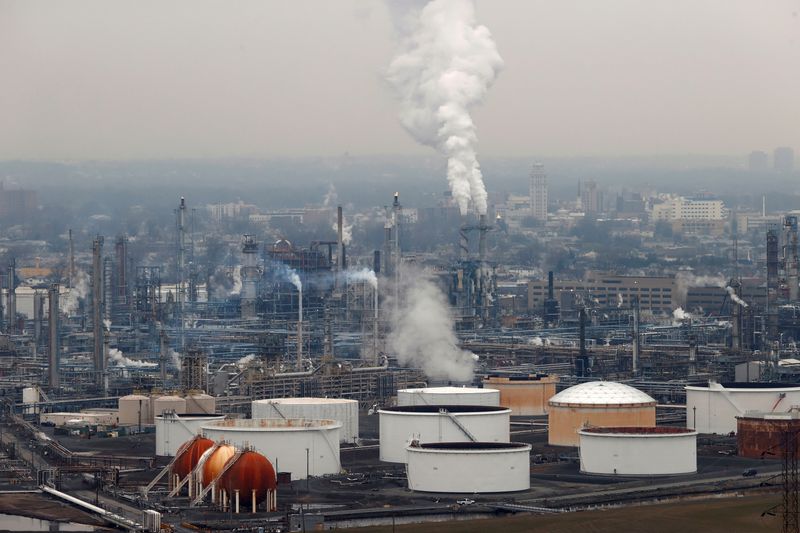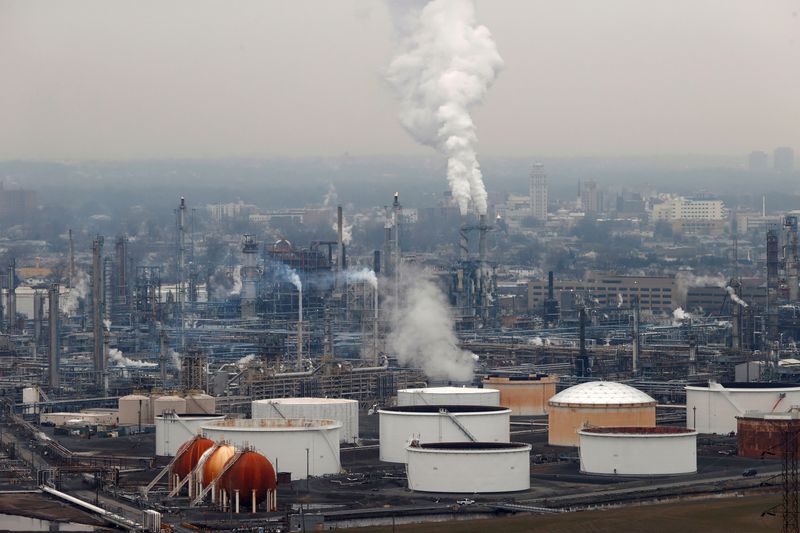Commodities
Oil prices take a small loss in seesaw session


© Reuters. General view of oil tanks and the Bayway Refinery of Phillips 66 in Linden, New Jersey, U.S., March 30, 2020. REUTERS/Mike Segar/file photo
By Erwin Seba
HOUSTON (Reuters) – and futures finished at a small loss following a see-saw session, in which prices fell more than $1 a barrel at one point on Friday, as traders tried to reconcile mixed signals for oil demand in the coming year.
Brent futures settled down 6 cents, or 0.08%, at$76.55 a barrel. U.S. West Texas Intermediate (WTI) crude finished down 15 cents, or 0.21%, at $71.43.
The market tumbled earlier in the session after a New York Federal Reserve Bank manufacturing survey showed a third month of declines in new orders, which could be a sign of weaker demand for oil in the coming year.
“What started the sell off was the sharp drop in the New York manufacturing numbers,” said Phil Flynn, analyst at Price Futures Group.
“This market seems a little more sensitive to every new headline,” Flynn added. “They’re still not sure we’ve found the bottom to this market.”
Traders were also shaken by comments from New York Federal Reserve Bank President John Williams on Friday about hopes for interest rate cuts in the coming year.
“We aren’t really talking about rate cuts right now,” Williams said in an interview with CNBC. When it comes to the question of lowering rates, “I just think it’s just premature to be even thinking about that” at this point, he said.
On Thursday Federal Reserve Chairman Jerome Powell said interest rate hikes intended to curb inflation were likely at an end, but left open the possibility for further increases.
The dollar fell to a four-month low on Thursday after the U.S. central bank after Powell’s comments, seeing signs lower borrowing costs are coming in 2024. The was broadly steady on Friday.
A weaker dollar makes dollar-denominated oil cheaper for foreign buyers.
World oil consumption will rise by 1.1 million barrels per day (bpd) in 2024, the IEA said in a monthly report.
While that is a 130,000-bpd increase from its previous forecast, the estimate is less than half of the Organization of the Petroleum Exporting Countries’ (OPEC) demand forecast of 2.25 million bpd.
OPEC and its allies led by Russia, in late November agreed on voluntary cuts of about 2.2 million bpd lasting throughout the first quarter.
“The markets in general and oil in particular are trying to sort out what’s going on,” said John Kilduff, partner with Again Capital LLC. “Everyone’s trying to feel their way.”
Money managers cut their net long U.S. crude futures and options positions in the week to December 12, the U.S. Commodity Futures Trading Commission (CFTC) said on Friday.
Another bullish signal for oil markets on Friday was the lower drilling rig count from energy technology firm Baker Hughes. The oil and gas rig count, an early indicator of future output, fell by 3 to 623 in the week to Dec. 15.
Baker Hughes said U.S. oil rigs fell 2 to 501 this week, while gas rigs were unchanged at 119. That brings the rig count down from a post-pandemic high of 784 in December 2022 due to a drop in oil and gas prices.
Commodities
Oil prices rise; U.S. crude inventories plunge, Russia-Ukraine truce eyed
Commodities
India’s Reliance to stop buying Venezuelan oil over US tariffs, sources say
Commodities
Oil prices climb on Venezuela supply worries

 Forex3 years ago
Forex3 years agoForex Today: the dollar is gaining strength amid gloomy sentiment at the start of the Fed’s week

 Forex3 years ago
Forex3 years agoUnbiased review of Pocket Option broker

 Forex3 years ago
Forex3 years agoDollar to pound sterling exchange rate today: Pound plummeted to its lowest since 1985

 Forex3 years ago
Forex3 years agoHow is the Australian dollar doing today?

 Cryptocurrency3 years ago
Cryptocurrency3 years agoWhat happened in the crypto market – current events today

 World3 years ago
World3 years agoWhy are modern video games an art form?

 Commodities3 years ago
Commodities3 years agoCopper continues to fall in price on expectations of lower demand in China

 Economy3 years ago
Economy3 years agoCrude oil tankers double in price due to EU anti-Russian sanctions























